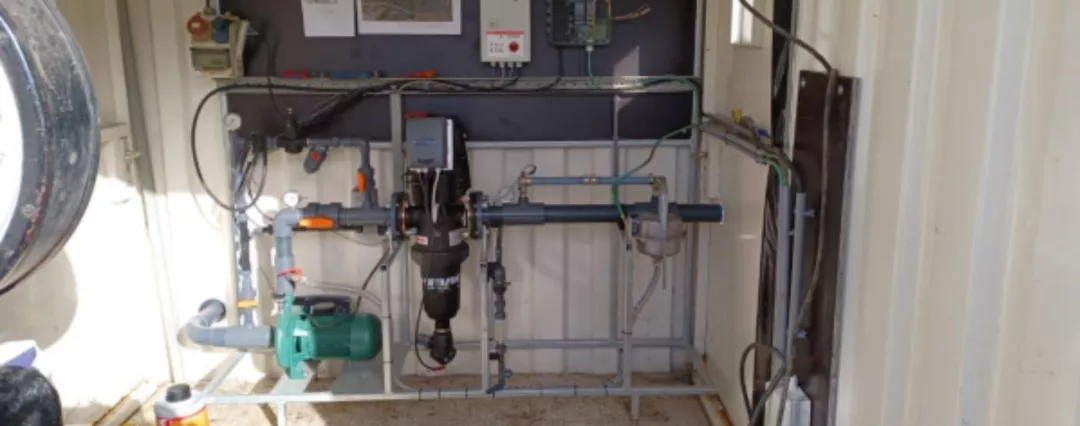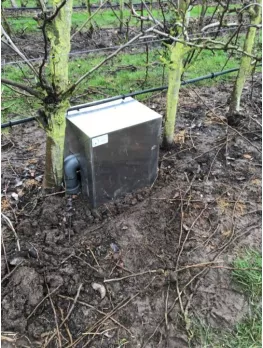General information
RDP Priority
- P4. Ecosystems management
RDP Focus Area
- 4B: Water management
RDP Measure
- M04: Investments in physical assets
Beneficiary type
- Farmer / land manager
Summary
In this project, a fertigation system was installed at a small family farm in Gelderland, the Netherlands. The farm grows apples and pears and needed to improve the effectiveness of its water consumption. The new fertigation system measures the need for water by using sensors and provides water and/or a mix of water, dissolved minerals and fertiliser to individual plants and trees through pumps and valves. The new programmable irrigation system has reduced the consumption of water by two thirds and made the use of minerals and manure more efficient.
Results
- The water consumption of the farm was reduced by two thirds.
- By adjusting minerals and manure more efficiently, the need for tractor usage in the fields was reduced, which benefitted the fields and the environment by reducing fuel consumption.
Ressources
Documents
Context
Henry van Steenis is a family farm business in the village of Wadenoijen, in the province of Gelderland. The farm grows apples and pears on nine hectares of fertile soil in the delta area of the Netherlands. The orchards are surrounded by other fruit and arable farms. Growing trees for fruits requires water and minerals. In dry summers, this demands a lot of water. In the past, diesel was used to pump high amounts of water to the orchards. In addition, the spraying of water not only reached the trees, but also the grass and the surrounding areas which was inefficient.
With increasingly drier summers and more frequent water shortages, the local water board set a challenging agenda to reduce unnecessary water usage and improve the overall efficiency of water consumption. Even when a farm is located near a river, such as Henry van Steenis', water meters and measurements are still required. The water challenge has become more urgent over the years requiring more effective solutions.
The technique of fertigation relates to a controlled irrigation system that not only provides targeted water supply to individual plants/trees but also can supply water-dissolved fertiliser to the plants. The project idea was to invest in such a fertigation system to better comply with the water board’s requirements for more efficient water usage. However, due to the relatively small size of the farm and the large investment needed, funding needed to be sourced.
Objectives
The objective of this project was to reduce water consumption by installing a fertigation system for nine hectares of fruit plantations. The fertigation system has a pump house/unit, underground pipes and above ground pipes to accommodate the roots and structure of the trees.
The system has a computer-based operating programme that improves data use and can be programmed at specific settings. For example, it can distribute water and fertiliser by pumping for one hour in the early morning.
Activities
The project activities involved several installations on the field, including a pump with a computer application and management programme. Using this system, water, minerals and manure are pumped to the trees. The rate depends on the soil humidity, which is measured by sensors responding to the trees' water needs.
In addition to the pump house, a container for minerals and fertilisers was installed and connected to the irrigation pipes and pump. This process regulates the distribution of the minerals and fertilisers and their transport to the trees. This container needs to be refilled around once a week.
The project further installed transport pipes from the pump house to the fields. The fields were divided into seven sections, whereby the pipes can be opened or closed via electrical controls. Finally, tubes were installed in each section and aligned with the tree rows. The tubes were installed 30 cm above the surface with a small hole every 30 cm to release the water and fertiliser.
Main results
- The fertigation system was installed successfully across nine hectares of tree plantations.
- The previous water consumption of the farm was reduced by two thirds.
- By adjusting minerals and manure more effectively, the need for tractor usage in the fields was reduced, which benefitted the fields and the environment by reducing fuel consumption.
- The small family business would not have been able to install a system like this without the availability of EAFRD funding. The subsidy has, therefore, enabled the small family farm to contribute effectively to improving the environment by reducing its water and fossil fuel consumption.
- The investment enabled the farmer to make better use of monitoring data. This is a benefit to both farmers and the environment.
Key lessons
- CAP funding enables small companies and family farms to make investments and environmental contributions that would otherwise have been too expensive due to their small size.
- The farmer applied for EAFRD funding with the help of an advisor, which worked well. However, it also indicates that the application process is still regarded as daunting and requires expert assistance, particularly for inexperienced farmers.
This system brought us a lot. We now use much less water and drive less through our fields.

